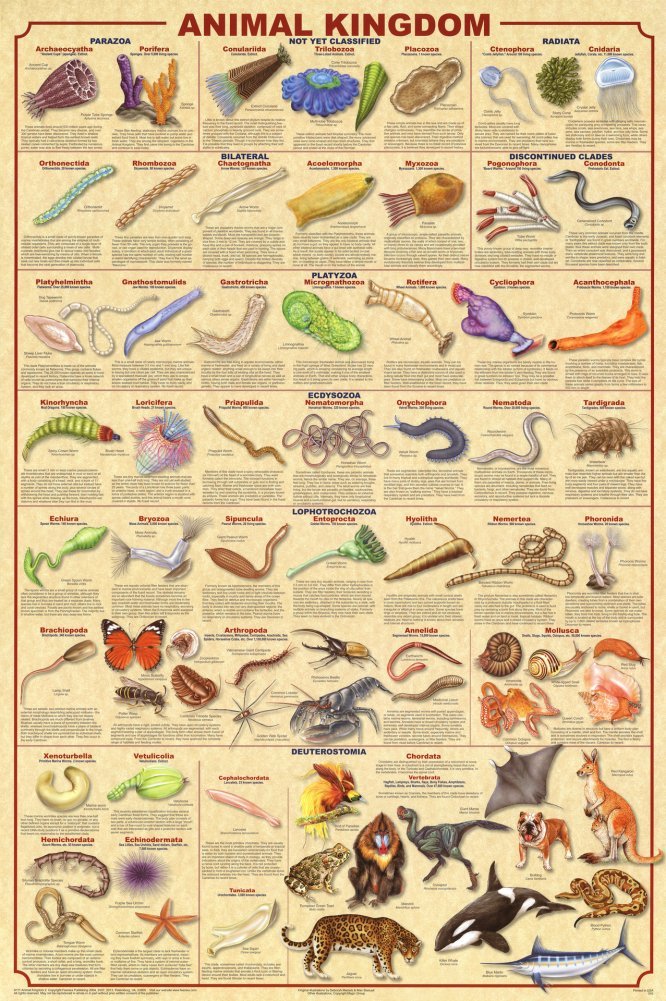
(24×36) Laminated Animal Kingdom 2 Educational Science Chart Poster
The word ‘animal’ is derived from the Latin word animalis which means ‘having breath’. The Kingdom Animalia is characterized by eukaryotic and heterotrophic organisms.
They are multicellular and lack cell wall. They depend directly or indirectly on plants for their food. Food is ingested and digested in their internal cavity and food reserves are stored as glycogen or fat. Nutrition is by ingestion of food.
Animals range in size from no more than a few cells to organisms weighing many tons, such as blue whales and giant squid.
By far most species of animals are insects, with groups such as mollusks, crustaceans, and nematodes also being especially diverse.
By this measure our own group, the vertebrates, is relatively inconsequential from a diversity perspective.
The number of invertebrate species far outweighs the number of vetebrate species on Earth; only about 4% of animals have backbones. Some estimate there are as many as 10 million species of arthropod alone, making up to 80% of all animals.
Arthropods include animals such as centipedes, crabs, insects, and spiders. And with over a million species of arthropods, this means that the majority of animals species come from a group of critters that give most folks the creeps!
Animals follow a definite growth pattern, the adults have a definite shape and size. Higher forms of animals exhibit well developed sensory and neuromotor mechanism.
The bodies of most animals (all except sponges) are made up of cells organized into tissues, each tissue specialized to some degree to perform specific functions.
In most, tissues are organized into even more specialized organs. Most animals are capable of complex and relatively rapid movement compared to plants and other organisms.
Most reproduce sexually, by means of differentiated eggs and sperm. Most animals are diploid, meaning that the cells of adults contain two copies of the genetic material.
Most of the organisms are capable of locomotion. Reproduction is by copulation of male and female which is followed by development in embryonic stages.
There are around 9 to 10 million species of animals, and about 800,000 species are identified. Fossil records of animals were found in the era of the Cambrian explosion, about 540 million years ago.
Animals are divided into various sub-groups, biologists have identified about 36 phyla within the animal kingdom including birds, mammals, reptiles, fish, amphibians etc.
Kingdom Animalia has approximately 36 sub-divisions known as ‘phyla’. Each phyla share particular properties structurally and functionally which together separate it from other phyla. Below are the most common phyla classified under traditional biological methodology.
Phylum Porifera – They are primitive organisms, most of them are salt-water sponges. They do not have organs or nerve cells or muscle cells. Approximately, 8,000 species exist today. Example: Sycon, Euspongia, Spongilla.
Phylum Coelentrata (Cnidaria) – This group is composed of jelly-fish and other lower aquatic animals. Approximately, 15,000 species exist today.Example: Aurelia, Adamsia.
Phylum Platyhelminthes – This group consists of flat worms. They inhabit both marine and fresh water habitats and they are mostly endoparasites found in animals. Example: Taenia, Fascicola.
Phylum Aschelmeinthes – It is a group of round worms, most of them are parasites. This phylum consists of about 80,000 parasitic worms.
Phylum Annelida – They are present in aquatic, terrestrial and are free-living or parasitic in nature. This phylum comprises of segmented worms. Example: Earthworm, Leech etc.
Phylum Arthropoda – This is the largest phylum which consists of insects. There are over 1 million species of insects existing today. Example: Locusts, Butterfly, Scorpion, Prawn.
Phylum Mollusca – It is the second largest phylum. They are terrestrial and aquatic. Example: Pila, Octopus.
Phylum Echinodermata – This consists of sea stars and sea urchins. There are about 6,000 species. Example: Asteria, Ophiura.
Phylum Chordata – Animals of this phylum have a characteristic feature of presence of notochord, a dorsal hollow nerve cord and paired pharyngeal gill slits. Within this phylum advanced group called vertebrates which include fish, amphibians, reptiles, birds and mammals.
Animals have a profound impact on all other forms of life on earth. Animals influence the composition of the atmosphere, consuming oxygen and releasing carbon dioxide.
As the largest mobile organisms on earth, they even affect the landscape around them. Many animals dig burrows, while beavers dam rivers to create ponds and elephants dig up underground water sources.
Humans are also considered animals and no other animal has done more to change the makeup of the Earth’s surface.
Plants, in particular, show the profound influence animals have had on life. Flowering plants evolved to depend on insect or other animal pollinators.
Many plants also rely on animals to disperse their seeds. Grasslands, depend on animals for their maintenance, since without them grasses would be overtaken by larger plants more quickly.
If you have any information,questions, or feedback you would like to include in this webpage.
Please email momo19@naturekingdoms.com or leave your comments below.